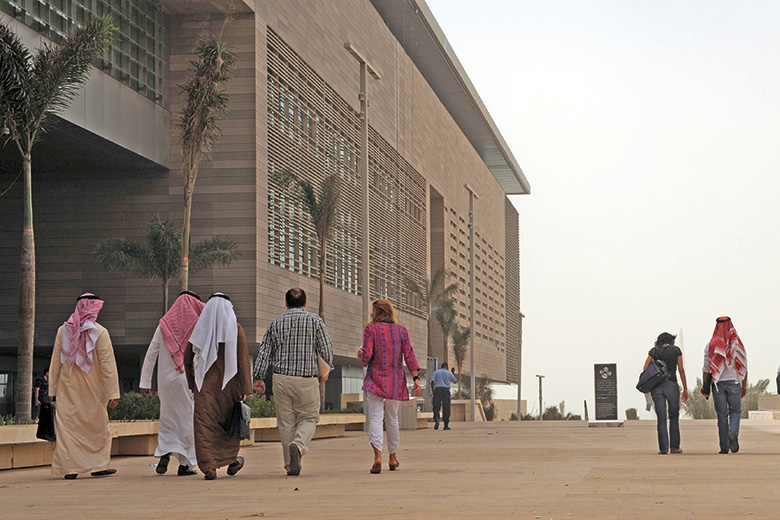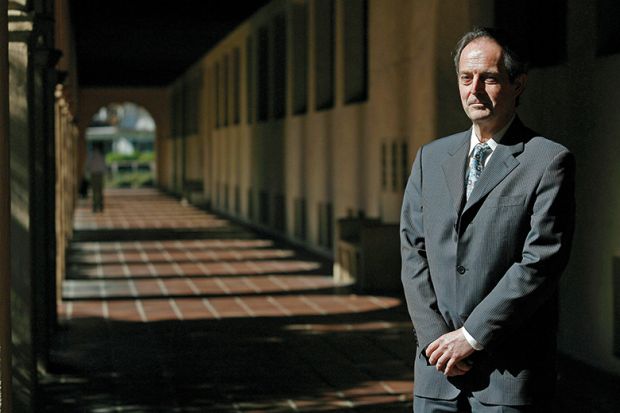From the Deep South of the US to the Arabian peninsula, Jean-Lou Chameau is the university leader with the Midas touch.
At the Georgia Institute of Technology, the California Institute of Technology and, most recently, King Abdullah University of Science and Technology, everything he has touched has seemingly turned to gold.
The French civil engineer, who announced earlier this year that he is to retire in August, was instrumental in transforming Georgia Tech from a locally focused state university to one of the most renowned higher education institutions in the world during his time as provost in the early 2000s. In the latest Times Higher Education World University Rankings, Georgia Tech is joint 33rd with the University of Melbourne: Australia’s highest ranked institution.
Then, during his seven-year reign as president of Caltech, he propelled the small, specialised university to number one in the THE World University Rankings, ending Harvard University’s seven-year reign (in the latest ranking it was nudged down to second by the University of Oxford).
And in his current role as president of KAUST, a private graduate research institution established in Saudi Arabia in 2009, he has developed one of the globe’s fastest-rising higher education institutions. As a graduate-only institution it is not eligible for THE’s rankings, but it was ranked 19th in Nature Index’s Rising Stars listing last year, which identifies the institutions that have shown the most significant growth in their number of high-quality research publications.
What is the secret to Chameau’s success – and to his consequent status as one of the most influential leaders in global higher education? His answer is simple: “great facilities” and “being able to provide sustained support to people”.
At KAUST, the late Saudi monarch after which the institution is named provided the finances necessary to offer both of those things – including an endowment that allows the university to support long-term research without the need for its researchers to obtain external grants.
“A colleague I knew relatively well joined us a few years back,” Chameau recalls. “As soon as he arrived he said: ‘I am back in my lab with my students, as opposed to being in my office writing proposal after proposal to keep my research afloat. If you are a scientist and you have the best laboratories and people telling you: ‘Here are the resources to do exciting things’, that’s heaven!”
Of course, most institutions are not as well endowed as KAUST. But Chameau sees it as the duty of leaders of all research universities to secure enough private funding to provide “a layer of support to faculty”, so they are not purely reliant on competitive grants to do their work. Such funding may “in some cases [account for] only 5 per cent” of a faculty member’s funding portfolio, but even a small amount allows “free thinking”, he says.
This approach was a vital element of his success at Caltech, Chameau says. “When you provide [academics with those] additional resources for a year or two – or more – they may look at new areas and start to produce some work that later on leads to a research grant. You have to find a way to support creativity.”
Another factor that is key to attracting top researchers and allowing them to thrive is to “create an environment where expectations are high and where people compete with themselves to be the best that they can”.
University leaders must convey that they want their academics to “address important, difficult questions. Sometimes the question is important because you can see it would have a major impact on society, [but] it can also be important [simply] because something is not known,” Chameau says.
But there is also such a thing as too much freedom, and there must also be “some checks and balances” – although he cautions that these are often imposed in a “fairly ad hoc and subtle way” even at top universities.
At Georgia Tech, monitoring consisted of annual reviews of the research impact of faculty (conducted by more senior colleagues) and a “more intense” review “every few years”. But Chameau is against taking too formulaic an approach. “[Assessing] impact is not only [a matter of] counting the number of publications [someone has produced] or counting their citations. [You have to] really try to figure out what their work is about and what it is [contributing] to knowledge,” he explains.
“If it is very pure science, [impact] may simply mean that other people are using the developments to move forward in the same area. For people who are doing more applied work, [the question is whether] they are starting to have impact on some potential solutions to problems that exist in society.”
Chameau will retire from a higher education sector that is vastly different from the one in which he began his leadership career more than 20 years ago.
One significant development has been internationalisation. The Hong Kong University of Science and Technology was one of the first institutions to recruit talent worldwide in a serious and focused way, Chameau says. But while all leading research universities now claim to do the same, his sense is that the reality often remains far more insular – especially in the US. International mobility, in his estimation, is still largely confined to “a layer of people that are extremely talented”. And while there is “aggressive hunting being done by universities for those people”, the idea that some countries are being systematically denuded of their academic talent is fallacious, he says: “We tend to make too much of [a supposed] brain drain.”
The “large majority” of foreign scholars recruited by US institutions are, in fact, “people who are already in the US, even if they came from another country [originally, with just] a few here and there from the UK, Switzerland or Germany. There are very few from Asia or other parts of the world. So although we say we recruit worldwide, we don’t truly.” By contrast, leading an institution in the Middle East has prompted Chameau to find and attract “amazing” scholars from countries such as South Korea and Singapore, who “would not have been on the radar screen when I was at Caltech”.
Another more recent development, particularly in the West, has been a decline in the perceived public value of universities, and an increasing mistrust of experts.
Chameau believes that many universities now try to be “good at everything” and, in the process, either forget or neglect to shout about their core missions. At Georgia Tech, that mission is to educate a significant number of engineers who will then stay in the local area and work for companies or launch start-ups. Chameau recollects that when he first started working at the institution in 1991, he had a clear sense that “people in the state really viewed the university as being something that was helping the state of Georgia”. But conversations he had with residents on a recent trip to Atlanta left him with “the impression that it is now viewed as more elitist”.

Georgia Tech’s vastly increased number of international students is one possible reason. But another is simply the fact that “it is maybe highlighting more its research successes than [its contribution to] the day-to-day economy”. So the solution to the public relations issue is a revised communication strategy rather than any real shift in priorities: a case of “showing the local people that you have the impact that they expect you to be having”.
The public are also potentially put off by US universities’ “reputation for being cry babies” when it comes to budgetary pressures: their sense that “they should be immune to cuts”. But that decline in funding means that many US institutions are now “spread too thinly” in Chameau’s view, trying to maintain broad disciplinary coverage when some of them might be better off emulating Caltech’s iconic model of “doing a few things only, and doing them extremely well. What was important 30 years ago is sometimes not as important now. So you have to be willing to shift your activities into a new area,” he says.
When Donald Trump became US president in January, many within the sector assumed that his administration would further accelerate cuts to higher education. And, sure enough, the Republican commander-in-chief’s first budget proposed deep cuts to the National Institutes of Health and the National Endowment for the Arts, among other funders. But, even speaking ahead of the reversal of those cuts by the Republican-dominated Congress last month, Chameau is not overly concerned about Trump, claiming that Republicans and Democrats “tend to agree that science and research remains important to the country. I’ve been involved in many, many budget cycles in Washington and one year one [party] is more positive and one is less, but there is [always] an understanding, an appreciation for research and science. I feel that will remain. The federal budget process will ultimately continue to foster US research agencies and new investments in frontier science.”
Last year, Nobel laureate and University of California, Berkeley physics professor Saul Perlmutter told delegates at the THE World Academic Summit at Berkeley that he would not have been able to make his prizewinning discovery in today’s research funding environment. But Chameau says that while the National Science Foundation is “still receiving pressure to show the impact it had yesterday”, the diverse range of funding sources for US institutions means that the “momentum remains” in US basic science.
Last year, for example, scientists affiliated with the LIGO Scientific Collaboration, a network of more than 1,000 physicists around the world searching for gravitational waves, announced that they had finally struck gold – 100 years after Einstein predicted the existence of gravitational waves and assumed they would be nearly impossible to detect.
The project had received more than 20 years of funding from the NSF (as well as from multiple other funders around the world), and “at many different times people said [the NSF funding] is going to end”, recollects Chameau. But, “ultimately, we always found a way to get the resources” – despite the fact that gravitational waves are “pure science” and may never have a useful application.
But while Chameau is relaxed about the US picture, he is less optimistic about the outlook for UK research if Brexit forces British universities out of European Union funding programmes.
“The UK has done very well to attract outstanding people from Italy, Spain, France, working on major grants supported by the EU programmes,” he says. “The large EU grants have been very attractive to people because…the support is there for a number of years, and at a fairly decent level.”
If it is lost, he fears, UK universities will lose some “very good people”.
In many cases academic retirement can seem a bit of a misnomer, with scholars remaining academically active long after they have supposedly signed off.
As Lincoln Allison, emeritus reader in politics at the University of Warwick, wrote recently in THE: “Academic work just lingers in ways that other work does not: doctoral students don’t finish when you retire, and you are still somebody’s obvious choice to put a particular case at a conference or examine a particular candidate or review a particular book.”
Chameau also intends to keep at least one foot in higher education after he steps down from KAUST, noting that it is “a privileged life” to work in “such an exciting environment” as a university.
“Leaving aside all those problems [stemming from the fact] that you have to fight for research funding, and [that] expectations are high…professors in academia can decide what they do. So it provides very unique opportunities,” he says. This contrasts with industry research – of which Chameau has personal experience – where “you cannot entirely decide what it is that you are going to do”.
Academia is also “a life where you are constantly engaged with younger people”, he adds. “Every year there are new faces, and…they look [ever] younger to you as you age. I think there is a dynamism in that, which becomes part of you, [part of] your DNA, which means that when you retire from your main activity, there is still a desire to stay engaged intellectually.”
However, Chameau agrees that there are “too many professors” who remain in active teaching and research positions for too long in the US, where there is no formal retirement age. “At some stage you have to give opportunities to younger people. It is possible to remain engaged without being a full member of the institution,” he says.
Chameau will split his time between Paris and the US once he leaves KAUST, but he has not made any formal plans about what he will do, apart from continuing to serve “on a board or two”.
“The only thing I know is that I’m going to be quite active in research and education, and maybe work in economic development,” he says.
But he does know for certain that a life of leisure would not suit him. “I don’t play golf and I don’t like fishing,” he says.
POSTSCRIPT:
Print headline: The alchemist
Register to continue
Why register?
- Registration is free and only takes a moment
- Once registered, you can read 3 articles a month
- Sign up for our newsletter
Subscribe
Or subscribe for unlimited access to:
- Unlimited access to news, views, insights & reviews
- Digital editions
- Digital access to THE’s university and college rankings analysis
Already registered or a current subscriber? Login







